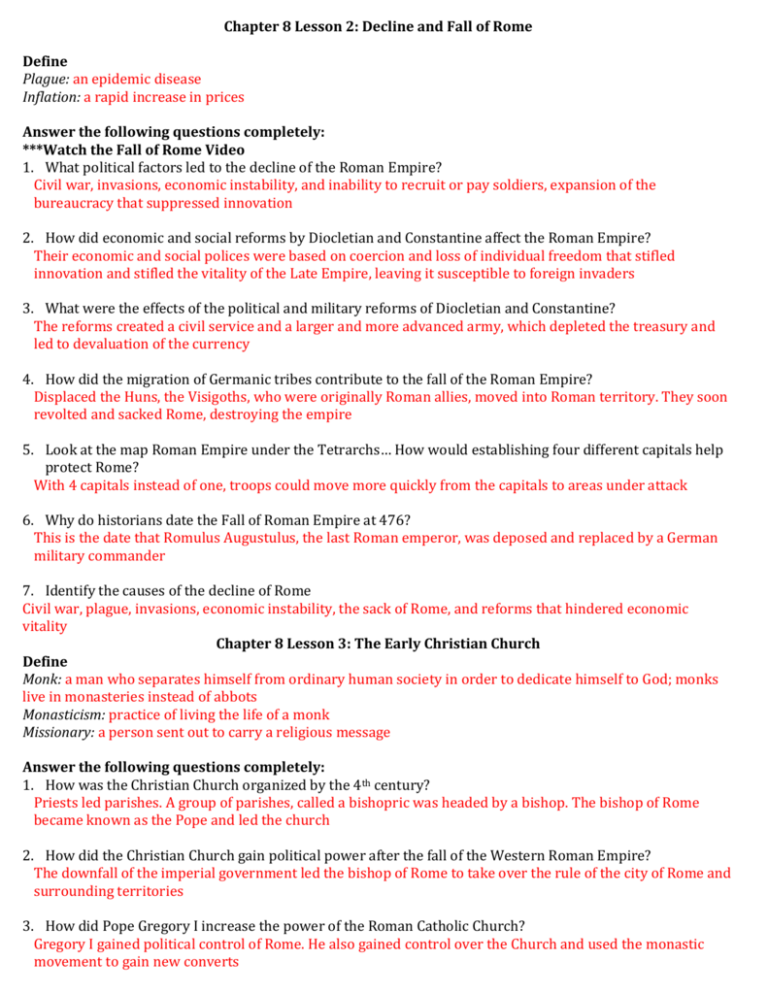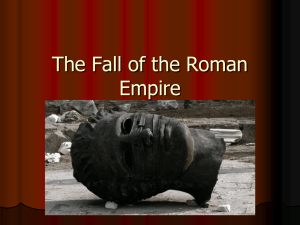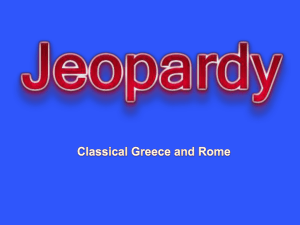Byzantine Empire Key (2) - McKinney ISD Staff Sites
advertisement

Chapter 8 Lesson 2: Decline and Fall of Rome Define Plague: an epidemic disease Inflation: a rapid increase in prices Answer the following questions completely: ***Watch the Fall of Rome Video 1. What political factors led to the decline of the Roman Empire? Civil war, invasions, economic instability, and inability to recruit or pay soldiers, expansion of the bureaucracy that suppressed innovation 2. How did economic and social reforms by Diocletian and Constantine affect the Roman Empire? Their economic and social polices were based on coercion and loss of individual freedom that stifled innovation and stifled the vitality of the Late Empire, leaving it susceptible to foreign invaders 3. What were the effects of the political and military reforms of Diocletian and Constantine? The reforms created a civil service and a larger and more advanced army, which depleted the treasury and led to devaluation of the currency 4. How did the migration of Germanic tribes contribute to the fall of the Roman Empire? Displaced the Huns, the Visigoths, who were originally Roman allies, moved into Roman territory. They soon revolted and sacked Rome, destroying the empire 5. Look at the map Roman Empire under the Tetrarchs… How would establishing four different capitals help protect Rome? With 4 capitals instead of one, troops could move more quickly from the capitals to areas under attack 6. Why do historians date the Fall of Roman Empire at 476? This is the date that Romulus Augustulus, the last Roman emperor, was deposed and replaced by a German military commander 7. Identify the causes of the decline of Rome Civil war, plague, invasions, economic instability, the sack of Rome, and reforms that hindered economic vitality Chapter 8 Lesson 3: The Early Christian Church Define Monk: a man who separates himself from ordinary human society in order to dedicate himself to God; monks live in monasteries instead of abbots Monasticism: practice of living the life of a monk Missionary: a person sent out to carry a religious message Answer the following questions completely: 1. How was the Christian Church organized by the 4th century? Priests led parishes. A group of parishes, called a bishopric was headed by a bishop. The bishop of Rome became known as the Pope and led the church 2. How did the Christian Church gain political power after the fall of the Western Roman Empire? The downfall of the imperial government led the bishop of Rome to take over the rule of the city of Rome and surrounding territories 3. How did Pope Gregory I increase the power of the Roman Catholic Church? Gregory I gained political control of Rome. He also gained control over the Church and used the monastic movement to gain new converts 4. What role did monks and monasteries play in the early Catholic Church? They represented the highest ideal of Christian life, and were social workers and educators 5. How did the Catholic Church affect the emerging medieval European civilizations? The Church was the center of village social life. Monasteries preserved ancient documents and provided education and health services. Popes gained political powers. 6. What was the Benedictine rule? Benedictine monks lived together as a community. Monks spent their days praying and working 7. What were the characteristics of Eastern Orthodoxy? Eastern Orthodoxy, which remains a vibrant form of Christianity today, developed the patriarchate, held a strong devotion to iconography, and used a unique calendar Chapter 8 Lesson 4: The Age of Charlemagne Define Wergild: “money for a man” the value of a person in money, depending on social status; in Germanic society, a fine paid by a wrongdoer to the family of the person he or she had injured of killed Ordeal: a means of determining guilt in Germanic law, based on the idea of divine intervention: if the accused person was unharmed after a physical trial, he or she was presumed innocent Answer the following questions completely: 1. How did the Germanic kingdoms influence the transformation of the Roman world? The Western Roman Empire had been replaced by a number of states ruled by German kings. The merging of Romans and Germans took different forms in the various Germanic Kingdoms 2. What was the significance of Clovis’ conversion to Christianity? It won him support of the Roman Catholic Church 3. What is a difference between the Roman and Germanic systems of justice? Crimes were considered to be against society in the Roman system but against the family in the Germanic system 4. What impact did Charlemagne have on the Frankish kingdom? He expanded it into an empire. He joined Roman, Christian, and German elements into one kingdom. He promoted a renewed interest in Latin Culture 5. Describe the roles of a. Women a women obeyed her father until she married and the fell under the legal domination of her husband b. Family the extended family was the cornerstone of German life. The extended family worked the land together and the passed it down to future generations. The family also provided protection and influenced the making of German laws 6. What is the significance of Charlemagne’s coronation in Rome? It gave vailitidy to the idea that the Roman Empire endured, and it symbolized the joining of Roman, Christian, and Germanic elements, since a German King was crowned emperor of the Romans by the Catholic pope 7. What was the significance of the Carolingian Empire in the progression of European history? It began the formation of medieval Europe 8. Why were Charlemagne and Clovis considered important leaders? Clovis was the first Germanic leader to convert to Christianity, which led to the spread of faith and political unification in Europe. Charlemagne connected Germanic, Roman, and Christian elements into an empire that formed the beginnings of medieval Europe Chapter 8 Lesson 5: The Byzantine Empire Define Patriarch: the head of the Eastern Orthodox Church, originally appointed by the Byzantine emperor Icon: pictures of religious images Idolatry: the worship of religious images Answer the following questions completely: 1. How did the Eastern Roman Empire evolve into the Byzantine Empire? External threats caused the empire to lose territory, and the empire shrank into a smaller empire held together by its spiritual values 2. What were the cultural contributions of the Byzantine Empire? Byzantine art focused on churches. Constantinople gained fame for its beauty 3. In what ways did Justinian influence Rome, Europe, Japan, and the state of Louisiana when he compiled what became known as the Justinian code? He simplified the voluminous roman legal materials and codified Roman law into a form used in both the east and the west. He passed down legal traditions to Europe, Japan, and the state of Louisiana 4. How was Theodora’s role different from that of many other women of the time period? She advised her husband on government policies and met with foreign envoys; she advocated for women, made divorce laws more favorable for women, and established laws that prevented women and girls from being forced into prostitution 5. What were the major problems faced by the Eastern Roman Empire after Justinian died? Too much territory to protect, far from Constantinople; an empty treasure; decline in population after a plague; renewed threats to its frontiers 6. What role did the Christian Church play in the Byzantine Empire? In large part it was a unifying social and political factor. The emperor appointed the church head. Artistic talent mostly went into building and decorating churches. However, religious controversy later caused a split 7. What threats did the Byzantine Empire face in the 11th century? The Seljuk Turks moved in Asia Minor threatening the empire’s food and manpower. Incompetent leaders led to political and social disorder 8. What effects did the expansion of trade have on the Byzantine Empire? Trade led to economic prosperity and wealth, which led to increased power 9. How did the use of icons lead to a schism between the Catholic Church and Eastern Orthodox Church? Popes condemned the use of icons, damaging relations between churches 10. What were the influences of impacts of the political and legal ideas contained in Justinian’s code of Laws? Justinian codified Roman law. This codification of Roman law became the political basis of imperial law in the Eastern Roman Empire until list end in 1453. Politically, it put forward the idea that the emperor was the authority and source of all law. More importantly, however, because it was written in Latin, it was also used in the West and became the basis for much of the legal system of Europe 11. How did Christianity serve as a unifying social and political factor in the Byzantine Empire? Christianity served as a unifying social and political factor in the Byzantine Empire in that the empire was built on the Christian faith that was shared in a profound way by almost all its citizens. An enormous amount of artistic talent was poured into the construction decoration to honor this faith. The emperor occupied a crucial position in the Byzantine state. Portrayed as chosen by God, he was crowned in sacred ceremonies and his subjects were expected to prostrate themselves in his presence. His power was considered absolute. Because the emperor appointed the head of the church (known as the patriarch), he also exercised control over both church and state. The Byzantines believed that God had commanded their state to preserve the true Christian faith. Emperor, church officials, ad state officials ere all bound together in service









